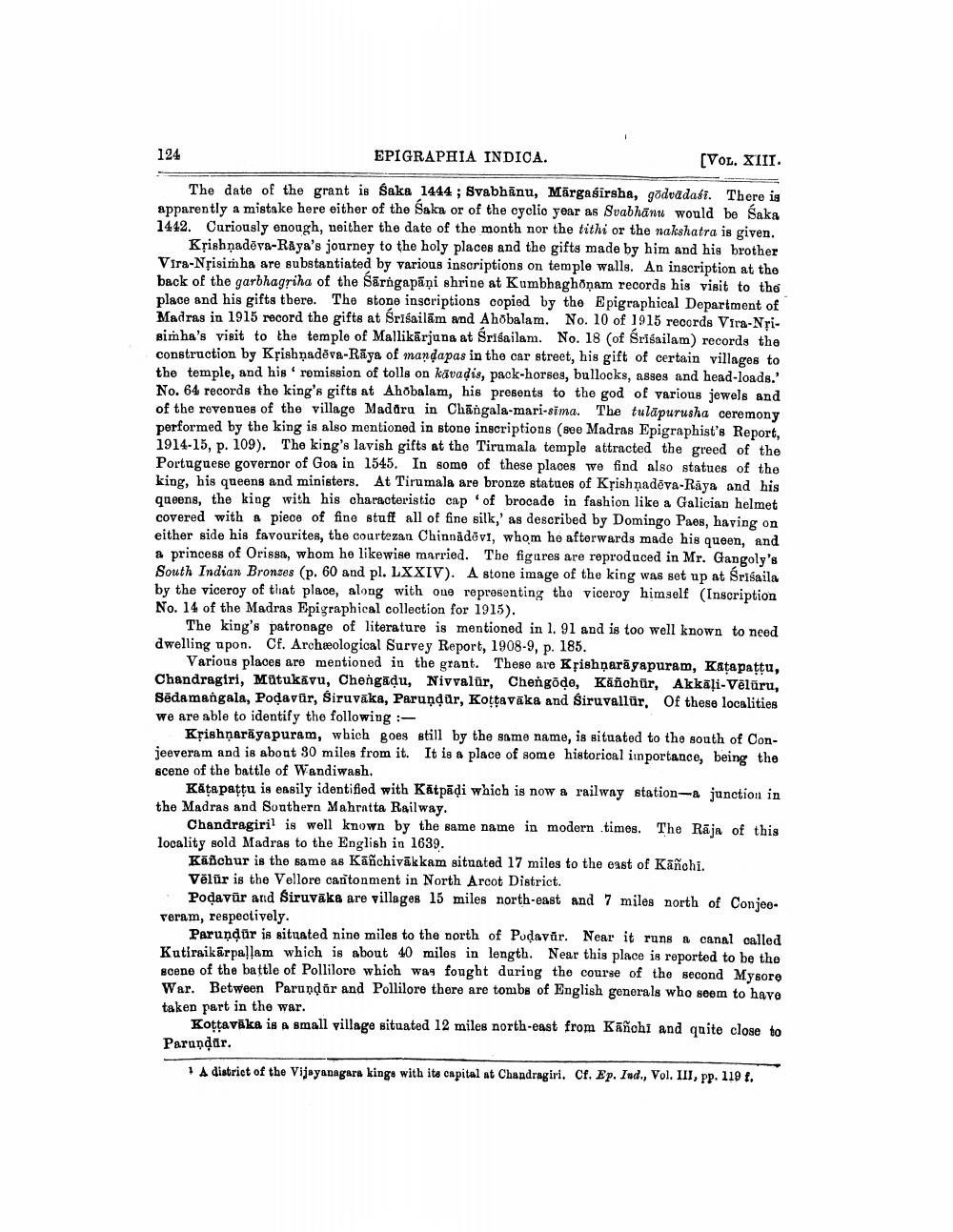________________
124
EPIGRAPHIA INDICA.
[VOL. XIII.
The date of the grant is Saka 1444 ; Svabhānu, Mārgasirsha, gõdvadasi. There is apparently a mistake here either of the Saka or of the cyclio year as Svabhann would be Saka 1442. Curiously enough, neither the date of the month nor the tithi or the nakshatra is given.
Krishnadeva-Raya's journey to the holy places and the gifts made by him and his brother Vira-Nrisimha are substantiated by various inscriptions on temple walls. An inscription at the back of the garbhagriha of the Sārngapāņi shrine at Kumbhaghonam records his visit to the place and his gifts there. The stone inscriptions copied by the Epigraphical Department of Madras in 1915 record the gifts at Srisailām and Ahobalam. No. 10 of 1915 records Vira-Nrisimha's visit to the temple of Mallikarjuna at Srisailam. No. 18 (of Srisailam) records the construction by Krishnadeva-Rāya of mandapas in the car street, his gift of certain villages to the temple, and his remission of tolls on kavadis, pack-horses, bullocks, asses and head-loads." No. 64 records the king's gifts at Ahobalam, his presents to the god of various jewels and of the revenues of the village Madaru in Chāngala-mari-sima. The tuläpurusha ceremony performed by the king is also mentioned in stone inscriptions (see Madras Epigraphist's Report, 1914-15, p. 109). The king's lavish gifts at the Tirumala temple attracted the greed of the Portuguese governor of Goa in 1545. In some of these places we find also statues of the king, his queens and ministers. At Tirumala are bronze statues of Ksish nadova-Raya and his queens, the king with his characteristio cap of brocade in fashion like a Galician helmet covered with a piece of fine stuff all of fine silk,' as described by Domingo Paes, having on either side his favourites, the courtezan Chinnadēvi, whom he afterwards made his queen, and & princess of Orissa, whom he likewise married. The figures are reproduced in Mr. Gangoly's South Indian Bronzos (p. 60 and pl. LXXIV). A stone image of the king was set up at Srisaila by the viceroy of that place, along with one representing the viceroy himself (Inscription No. 14 of the Madras Epigraphical collection for 1915).
The king's patronage of literature is mentioned in 1. 91 and is too well known to need dwelling upon. Cf. Archeological Survey Report, 1908-9, p. 185.
Various places are mentioned in the grant. These are Krishnară yapuram, Katapattu, Chandragiri, Mütukávu, Chengāļu, Nivvalūr, Chengode, Kāñchür, Akkāļi-Vēlāru, Sēdamangala, Podavür, Siruvāka, Parundur, Kottavāka and Siruvallür. Of these localities We are able to identify the following :
Krishnarayapuram, which goes still by the same name, is situated to the south of Conjeeveram and is about 30 miles from it. It is a place of some historical inportance, being the scene of the battle of Wandiwash.
Käta pațţu is easily identified with Kātpāļi which is now a railway station-a junction in the Madras and Southern Mahratta Railway.
Chandragiril is well known by the same name in modern times. The Rāja of this locality sold Madras to the English in 1639.
Kāñchur is the same as Kāñchivākkam situated 17 miles to the east of Kāñchi. Vēlür is the Vellore cantonment in North Arcot District.
Podavür and Siruvaks are villages 15 miles north-east and 7 miles north of Conjeo. veram, respectively.
Parundür is situated nine miles to the north of Podavăr. Near it runs a canal called Kutiraikārpallam which is about 40 miles in length. Near this place is reported to be the scene of the battle of Pollilore which was fought during the course of the second Mysore War. Between Parundär and Pollilore there are tombs of English generals who seem to have taken part in the war.
Kottavāka is a small village situated 12 miles north-east from KĀñohi and quite close to Parundir.
A district of the Vijayanagara kings with its capital at Chandragiri. Cf. Ep. Ind., Vol. III, pp. 119 f.




